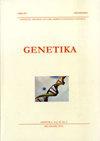Genotypic distribution of MSTN gene polymorphisms involved in racing performance in Camelus dromedarius
4区 农林科学
Q3 Agricultural and Biological Sciences
引用次数: 0
Abstract
Camel racing is one of the popular sports around the world and is growing rapidly especially in Gulf countries. Camel has adapted itself to harsh and draught climate of desert. ?his quality of camel makes it the best choice in racing industry. Pakistani breed Dromedarius camels are as good as Omani and Sudanese camel breeds in their racing potential. Myostatin (Growth differentiation factor 8) is a protein coded by MSTN gene. Polymorphism in MSTN play a significant role in growth of muscle, increasing fast glycolysis Type IIB muscle fiber, forming tubular aggregates in type IIB fiber by increasing the body strength and racing ability. This gene is also responsible for double muscle phenotype in bovines. In present study, Marecha and Brela camel breeds of Pakistan were studied for genomic characterization of MSTN gene. Blood samples were collected from the healthy animals between the age group of 2-4 years. Genomic DNA was extracted, amplified by using specific sets of primers, purified and sequenced by Sanger?s dideoxy chain termination method. No single nucleotide polymorphisms (SNPs) were found in the exon-3 of MSTN of Marecha & Brela, which shows that the gene is highly conserved among species while phylogenetic data of the dromedarius MSTN gene showed highest similarity with Bos taurus and least similarity with Gallus gallus. Genes that are similar to the camel MSTN are myostatin of Homo sapiens, Pan troglodytes, Bos taurus, Canis lupus, Rattus norvegicus. The significance of this study was to identify the genetic potential of Pakistani camel for racing that will help in the socioeconomic uplift of the local community. It will also help the camel breeders to select the best breed of camel & enhance their genetic potential by using least operating cost. That will in turn provide opportunity to the camel breeders to produce the best breed that will be selected by the trainers for racing that will provide another source of income for the local community and Pakistan?s camels will also be used in the racing industry.骆驼赛跑成绩相关MSTN基因多态性的基因型分布
骆驼赛是世界上最受欢迎的运动之一,特别是在海湾国家发展迅速。骆驼已经适应了沙漠严酷和干旱的气候。骆驼的品质使其成为赛马行业的最佳选择。巴基斯坦品种的骆驼在比赛潜力方面与阿曼和苏丹骆驼一样好。Myostatin(生长分化因子8)是由MSTN基因编码的一种蛋白。MSTN基因多态性在肌肉生长中发挥着重要作用,增加快速糖酵解的IIB型肌纤维,在IIB型肌纤维中形成管状聚集体,从而提高肌力和比赛能力。该基因也负责牛的双肌表型。本研究以巴基斯坦的Marecha和Brela骆驼品种为研究对象,对MSTN基因进行了基因组鉴定。从2-4岁年龄组的健康动物身上采集血液样本。提取基因组DNA,用特定的引物扩增,用Sanger?S二脱氧链终止法。Marecha & Brela的MSTN基因外显子3未发现单核苷酸多态性(SNPs),表明该基因在种间具有高度保守性,而dromedarius的MSTN基因与Bos taurus的相似性最高,与Gallus Gallus的相似性最低。与骆驼MSTN相似的基因有智人、类人猿、金牛、狼犬、褐家鼠的肌肉生长抑制素。这项研究的意义在于确定巴基斯坦骆驼赛跑的遗传潜力,这将有助于提高当地社区的社会经济水平。这也将有助于骆驼育种者以最小的运营成本选择最佳的骆驼品种,提高骆驼的遗传潜力。这反过来又将为骆驼饲养者提供机会,生产出最好的品种,由驯兽师挑选参加比赛,这将为当地社区和巴基斯坦提供另一种收入来源。美国的骆驼也将被用于赛马行业。
本文章由计算机程序翻译,如有差异,请以英文原文为准。
求助全文
约1分钟内获得全文
求助全文
来源期刊

Genetika-Belgrade
AGRONOMY-GENETICS & HEREDITY
CiteScore
1.80
自引率
0.00%
发文量
1
审稿时长
6-12 weeks
期刊介绍:
The GENETIKA is dedicated to genetic studies of all organisms including genetics of microorganisms, plant genetics, animal genetics, human genetics, molecular genetics, genomics, functional genomics, plant and animal breeding, population and evolutionary genetics, mutagenesis and genotoxicology and biotechnology.
 求助内容:
求助内容: 应助结果提醒方式:
应助结果提醒方式:


